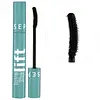Sephora Collection Love The Lift Curling + Volumizing Waterproof Mascara Versus e.l.f. cosmetics Lash 'N Roll Mascara
What's inside
What's inside
 Key Ingredients
Key Ingredients

 Benefits
Benefits

 Concerns
Concerns

No concerns
 Ingredients Side-by-side
Ingredients Side-by-side

Isododecane
EmollientCera Microcristallina
Emulsion StabilisingWater
Skin ConditioningCI 77499
Cosmetic ColorantKaolin
AbrasiveTrimethylsiloxysilicate
EmollientVp/Eicosene Copolymer
Euphorbia Cerifera Wax
Copernicia Cerifera Wax
Disteardimonium Hectorite
StabilisingButylene Glycol
HumectantSorbitan Isostearate
EmulsifyingPropylene Carbonate
SolventAcacia Senegal Gum
MaskingEthylhexylglycerin
Skin ConditioningPanthenol
Skin ConditioningPotassium Sorbate
PreservativeSodium Dehydroacetate
PreservativeCaprylyl Glycol
EmollientPolyester-4
Skin ConditioningTocopherol
AntioxidantIsododecane, Cera Microcristallina, Water, CI 77499, Kaolin, Trimethylsiloxysilicate, Vp/Eicosene Copolymer, Euphorbia Cerifera Wax, Copernicia Cerifera Wax, Disteardimonium Hectorite, Butylene Glycol, Sorbitan Isostearate, Propylene Carbonate, Acacia Senegal Gum, Ethylhexylglycerin, Panthenol, Potassium Sorbate, Sodium Dehydroacetate, Caprylyl Glycol, Polyester-4, Tocopherol
Water
Skin ConditioningRicinus Communis Seed Oil
MaskingStyrene/Acrylates Copolymer
Propylene Glycol
HumectantSynthetic Beeswax
Emulsion StabilisingCopernicia Cerifera Wax
Glyceryl Stearate
EmollientPvp
Emulsion StabilisingPolyamide-5
Skin ConditioningPolyacrylic Acid
Emulsion StabilisingPalmitic Acid
EmollientPEG-8 Caprylic/Capric Glycerides
EmulsifyingStearic Acid
CleansingMagnesium Aluminum Silicate
AbsorbentPhenoxyethanol
PreservativePEG-100 Stearate
Nylon-12
Aminomethyl Propanol
BufferingCeteareth-25
CleansingButylene Glycol
HumectantPEG-40 Hydrogenated Castor Oil
EmulsifyingEthylhexylglycerin
Skin ConditioningPolyquaternium-10
PEG-90m
Emulsion StabilisingCaprylyl Glycol
EmollientSodium Benzoate
MaskingSilica
AbrasiveXanthan Gum
EmulsifyingKaolin
AbrasiveTocopherol
AntioxidantWater, Ricinus Communis Seed Oil, Styrene/Acrylates Copolymer, Propylene Glycol, Synthetic Beeswax, Copernicia Cerifera Wax, Glyceryl Stearate, Pvp, Polyamide-5, Polyacrylic Acid, Palmitic Acid, PEG-8 Caprylic/Capric Glycerides, Stearic Acid, Magnesium Aluminum Silicate, Phenoxyethanol, PEG-100 Stearate, Nylon-12, Aminomethyl Propanol, Ceteareth-25, Butylene Glycol, PEG-40 Hydrogenated Castor Oil, Ethylhexylglycerin, Polyquaternium-10, PEG-90m, Caprylyl Glycol, Sodium Benzoate, Silica, Xanthan Gum, Kaolin, Tocopherol
 Reviews
Reviews

Ingredients Explained
These ingredients are found in both products.
Ingredients higher up in an ingredient list are typically present in a larger amount.
Butylene Glycol (or BG) is used within cosmetic products for a few different reasons:
Overall, Butylene Glycol is a safe and well-rounded ingredient that works well with other ingredients.
Though this ingredient works well with most skin types, some people with sensitive skin may experience a reaction such as allergic rashes, closed comedones, or itchiness.
Learn more about Butylene GlycolCaprylyl Glycol is a humectant and emollient, meaning it attracts and preserves moisture.
It is a common ingredient in many products, especially those designed to hydrate skin. The primary benefits are retaining moisture, skin softening, and promoting a healthy skin barrier.
Though Caprylyl Glycol is an alcohol derived from fatty acids, it is not the kind that can dry out skin.
This ingredient is also used as a preservative to extend the life of products. It has slight antimicrobial properties.
Learn more about Caprylyl GlycolCopernicia Cerifera Wax comes from a palm tree native to Brazil; another name for this ingredient is Carnauba Wax.
This ingredient is used to thicken texture and also leaves behind a film when applied.
Fun fact: This wax has the highest melting point of all natural waxes and low solubility.
Learn more about Copernicia Cerifera WaxEthylhexylglycerin (we can't pronounce this either) is commonly used as a preservative and skin softener. It is derived from glyceryl.
You might see Ethylhexylglycerin often paired with other preservatives such as phenoxyethanol. Ethylhexylglycerin has been found to increase the effectiveness of these other preservatives.
Kaolin is a clay. It is used for oil control and to help minimize pores. Like other clays, kaolin has the ability to absorb excess sebum or oil. This can help clean out pores and mattify the skin.
Some types of kaolin may have exfoliating properties. When water is added to kaolin, it becomes a paste with small abrasive particles.
Most kaolin is a white color, but may be pink/orange/red depending on where it comes from.
The name 'kaolin' comes from a Chinese village named 'Gaoling'. Kaolin clay comes from rocks rich in kaolinite. Kaolinite, the mineral, has a silicate layered structure. Kaolinite is formed from chemical weathering of aluminum siilicate minerals.
Besides skincare, kaolin is commonly used to make glossy paper, in ceramics, toothpaste, and as medicine to soothe stomach issues.
Learn more about KaolinTocopherol (also known as Vitamin E) is a common antioxidant used to help protect the skin from free-radicals and strengthen the skin barrier. It's also fat soluble - this means our skin is great at absorbing it.
Vitamin E also helps keep your natural skin lipids healthy. Your lipid skin barrier naturally consists of lipids, ceramides, and fatty acids. Vitamin E offers extra protection for your skin’s lipid barrier, keeping your skin healthy and nourished.
Another benefit is a bit of UV protection. Vitamin E helps reduce the damage caused by UVB rays. (It should not replace your sunscreen). Combining it with Vitamin C can decrease sunburned cells and hyperpigmentation after UV exposure.
You might have noticed Vitamin E + C often paired together. This is because it is great at stabilizing Vitamin C. Using the two together helps increase the effectiveness of both ingredients.
There are often claims that Vitamin E can reduce/prevent scarring, but these claims haven't been confirmed by scientific research.
Learn more about TocopherolWater. It's the most common cosmetic ingredient of all. You'll usually see it at the top of ingredient lists, meaning that it makes up the largest part of the product.
So why is it so popular? Water most often acts as a solvent - this means that it helps dissolve other ingredients into the formulation.
You'll also recognize water as that liquid we all need to stay alive. If you see this, drink a glass of water. Stay hydrated!
Learn more about Water